Overview
Within This Page
Auditorium space types are areas for large meetings, presentations, and performances. Auditorium space type facilities may include assembly halls, exhibit halls, auditoriums, and theaters. Auditorium space types do not include such features as sound reinforcement systems, audiovisual systems and projection screens, food service facilities, proscenium stages with heights greater than 50'– 0" or fly gallery, orchestra pits, revolving or hydraulic stage platforms, flying balconies, movable seating, or billboard systems.
Space Attributes
Auditorium spaces are designed to accommodate large audiences. As such, they tend to have wide spans and are multiple-stories high in order to accommodate seating, sightlines, and acoustical requirements. Raised stage/dais floors and special lighting equipment are often required as well. Typical features of Auditorium space types include the list of applicable design objectives elements as outlined below. For a complete list and definitions of the design objectives within the context of whole building design, click on the titles below.
Accessible and Functional / Operational
- Sloped Floors: Sloped floors, with level terraces for each row of seating, help provide the proper sightlines from the audience to the stage. Note that the bottom and intermediate rows should be directly accessible from entry levels to allow for Americans with Disabilities Act Accessibility Guidelines for Buildings and Facilities (ADAAG) compliant accessible seating positions. See also WBDG Accessible.
- Fixed Seats: Typically, fixed seats with tilting upholstered seat and back, integral arm and tablet arm are provided with articulated back for maximum occupant passage space between rows. The seats may be fully upholstered or wood contoured outer back and seat shells with wood armrests with tablet arm option and aisle light option at row ends. Seat number/row letters should be Americans with Disabilities Act (ADA) compliant. Wheelchair access option-removable seats in sections of two and accessible end chairs for mobility limited occupants should be provided. See also WBDG Accessible.
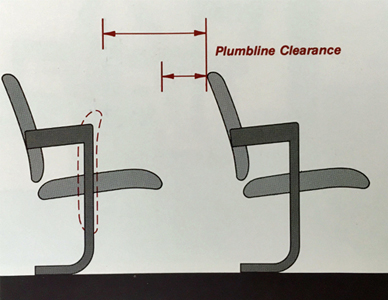
Building codes will provide auditorium seating layout and clearance requirements.
- Special Lighting: Dramatic lighting systems include front lighting, foot lighting, spot lights, follow spot lights, beam lights, and flood lights, and a projection room/booth with manual and programmable lighting controls, and space for the spot light operator. Lighting systems should be flexible to accommodate various performance venues (e.g., lectures, plays, musical performances, etc.) in the Auditorium. See also WBDG Electric Lighting Controls.
- Occupancy: Occupancy Group Classification is Assembly A1 or A3 as per IBC, with sprinkler protected construction, and GSA Acoustical Class A space requiring special acoustical design. See also WBDG Secure / Safe—Fire Protection.
Productive
- Special Acoustical Design: Quality acoustical characteristics are important in Auditorium spaces so that performances and presentations can be clearly heard and understood. For performance spaces and general presentation spaces, recommended noise criteria (NC) rating ranges from NC–20 to NC–30; recommended sound transmission class (STC) rating ranges from STC 40 to STC 50. Strategies to achieve the recommended NC and STC ranges include, for example: Type II vinyl wall covering and fabric covered acoustical wall panels for the interior wall finish in the auditorium; Type II vinyl wall covering for the stage area; Type II vinyl wall coverings for 1/3 of the front of the orchestra (audience) sidewalls and fabric covered acoustical panels for 2/3 of the back of the orchestra (audience) sidewalls; fabric covered acoustical panels for rear walls; and a plaster and plywood combination—because of their reverberation characteristics—for the ceiling. For more information, see WBDG Productive—Provide Comfortable Environments and Acoustic Comfort.
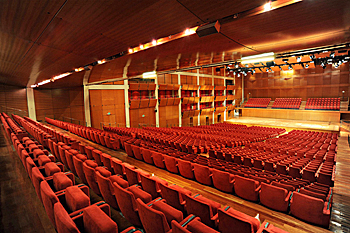
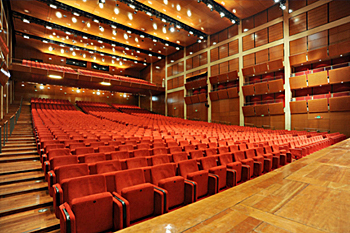
The Auditorium Giovanni Agnelli in Turin, Italy has variable ceiling height according to acoustic needs.
Photo Credits: Centro Congressi Lingotto
Sustainable
- Increased Cooling Capacity: Heating, ventilating, and air-conditioning (HVAC) systems for Auditorium spaces are sized and zoned to accommodate varying internal loads, which are a function of audience sizes, performance lighting loads, and projection equipment. Particularly, air handling units (AHUs) with increased cooling capacity should be zoned separately for the auditorium, lobby, projection spaces, stage areas, and audience seating areas. Also, the Auditorium typically has a separate AHU constant volume with modulated temperature control for ventilation. For more information, see WBDG High-Performance HVAC.
- Materials and Finishes: Use materials and finishes that meet sustainability requirements for Low or No-VOC as well as durability and low maintenance. Coordinate maintenance and replacements with sustainable O&M practices to ensure an overall healthy environment.
- Raised Floor: The recommended system for distribution of HVAC in auditorium spaces is ducted supply through floor vents with ducted ceiling return air vents in auditorium and lobby. In other spaces, ducted ceiling supply with return air ceiling plenum is recommended. Note that there should be transfer ducts at all acoustically rated partitions.
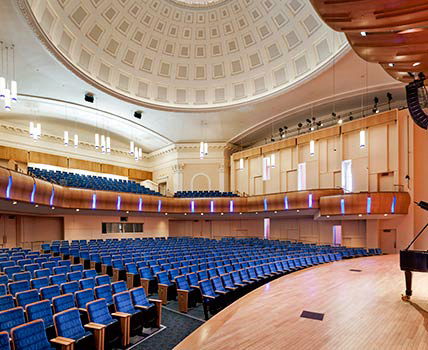
The historic 1927 Baldwin Auditorium at Duke University underwent renovations while incorporating significant sustainable design features and strategies such as energy and water efficiency, indoor air quality, and resource management, earning Silver Certification under the LEED™ for New Construction 2.2 Rating System. Pfeiffer Partners Architects.
Photo Credit: Duke University
Secure / Safe
- Fire and Life Safety: Proper notification systems, lighting, and signage are required to facilitate safe and speedy evacuations during regular events or an emergency in Auditorium spaces. Step lights recessed into floor risers at each seating tier and wall mounted low light level sconce lights along side walls are typical. Sprinklers should be provided per code and under stage platforms to suppress fires. Materials used should be non-combustible. Regular inspections should also be conducted and documented in order to prevent safety hazards. Plan for secure areas in and around the auditorium including unused parts of the building; separating audience from performers; and keeping unauthorized people from stage and catwalk areas. Staff should be trained in crowd management, First Aid, and Accessibility in order to support performers and audience needs and maintain a safe environment. See also WBDG Secure / Safe—Occupant Safety and Health and Secure / Safe—Fire Protection.
Example Program
The following building program is representative of Auditorium space types.
Auditorium
| Description Tenant Occupiable Areas |
Qty. | SF Each | Space Req'd. | Sum Actual SF | Tenant Usable Factor | Tenant USF |
|---|---|---|---|---|---|---|
| Entrance | 2,096 | |||||
| Lobby | 1 | 1,500 | 1,500 | |||
| Entrance Vestibules | 1 | 96 | 96 | |||
| Coat Check | 1 | 150 | 150 | |||
| Retail Area | 1 | 200 | 200 | |||
| Media Library | 1 | 150 | 150 | |||
| Main Auditorium | 4,800 | |||||
| Seating (300 seats) | 1 | 3,600 | 3,600 | |||
| Stage | 1 | 1,200 | 1,200 | |||
| Support Spaces | 1,300 | |||||
| Projection/Control Room | 1 | 300 | 300 | |||
| Equipment Storage | 1 | 300 | 300 | |||
| Rear Projection Room | 1 | 400 | 400 | |||
| Public Toilets (Male | 1 | 120 | 120 | |||
| Public Toilets (Female) | 1 | 180 | 180 | |||
| Tenant Suite | 8,196 | 8,196 | 1.14 | 9,375 | ||
| Tenant Usable Areas | 18,750 |
Example Plans
The following diagram is representative of typical tenant plans.
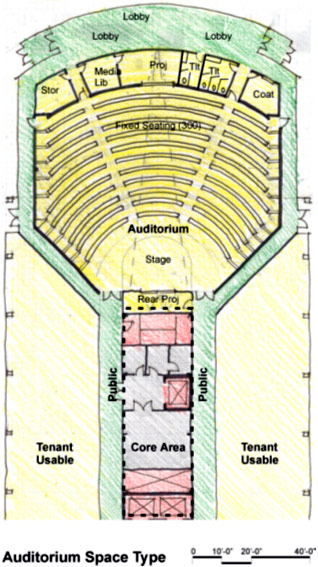
Example Construction Criteria
For GSA, the unit costs for Auditorium space types are based on the construction quality and design features in the following table . This information is based on GSA's benchmark interpretation and could be different for other owners.
Relevant Codes and Standards
The following agencies and organizations have developed codes and standards affecting the design of Auditoriums. Note that the codes and standards are minimum requirements. Architects, engineers, and consultants should consider exceeding the applicable requirements whenever possible.
- Americans with Disabilities Act (ADA)
- ASHRAE: Noise and Vibration Control
- Americans with Disabilities Act Accessibility Guidelines for Buildings and Facilities (ADAAG)
- GSA PBS-P100 Facilities Standards for the Public Buildings Service
- International Building Code
Additional Resources
Organizations and Associations
- Acoustical Society of America (ASA)—The Society is primarily a voluntary organization and attracts the interest, commitment, and service of a large number of professionals. Their contributions in the formation, guidance, administration, and development of the ASA are largely responsible for its world-wide preeminence in the field of acoustics.
- Institute of Noise Control Engineering—The Institute of Noise Control Engineering of the USA (INCE/USA) is a non-profit professional organization incorporated in Washington, DC. A primary purpose of the Institute is to promote engineering solutions to environmental noise problems.
Publications
- Architectural Graphic Standards, 12th Edition by American Institute of Architects, Dennis J. Hall. New York, NY: John Wiley & Sons, Inc., 2016.
- Auditorium Acoustics 101 – 104








